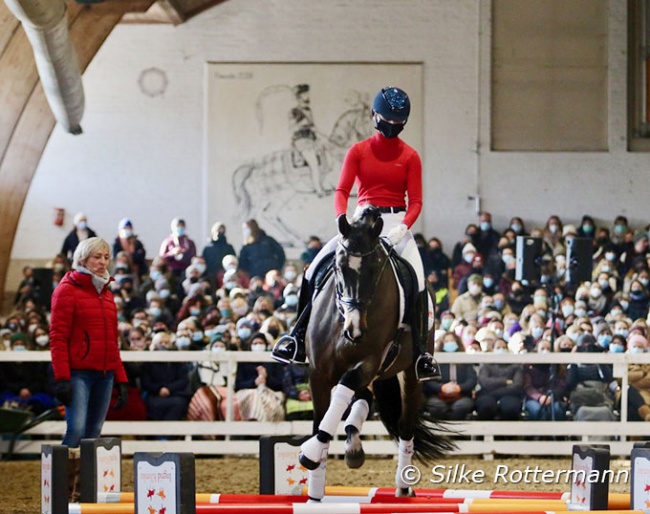
If an organizer manages to sign Ingrid Klimke for a masterclass or seminar, success seems guaranteed. The popularity of the petite descendant of Germany’s most famous equestrian family is undisputed and even seems to grow with the years.
While many events in Europe are currently rather cancelled than taking place, the National Horse Center (NPZ) in the heart of Switzerland’s capital Berne was able to host the Klimke masterclass as planned on 23 January 2022. They combined it with their traditional stallion show the evening before.
The weekend was blessed with fantastic winter weather and thanks to the enthusiastic Swiss audience it became a Klimke festival par excellence.
Braving Rush Hour Traffic
Driving from Germany to Switzerland on a Friday afternoon meant facing the insanity of weekend traffic in both countries. While my latest horrid record time to Switzerland (for a distance of 360 kilometers) stands at 11 hours, which I clocked in the summer 2021, this time it took almost eight hours to get to Berne on 21 January.
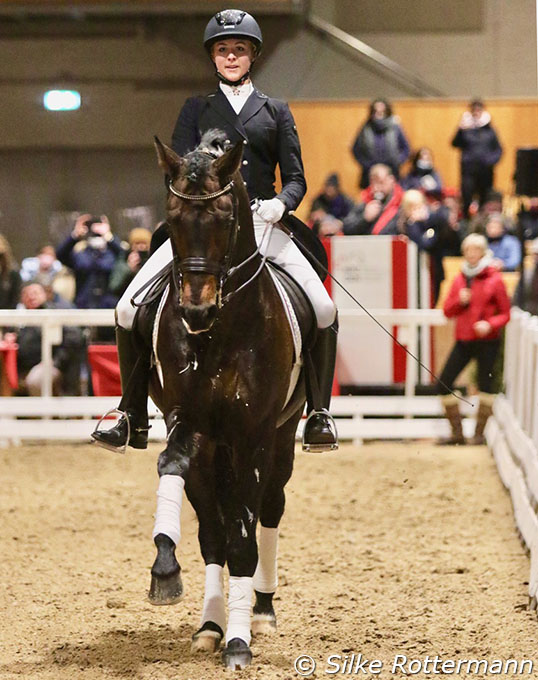
The world looked a better place with the early morning fog getting burnt away by the most gorgeous sunshine and a deep blue sky on Saturday morning 22 February. The snow capped Bernese mountains created a breathtaking backdrop and with the stallion show only kicking off at 5 pm, I took the opportunity to stroll through Berne and enjoy a dream-like winter day; the sort which seems impossible to get in my part of Germany this winter. It has been more or less permanently grey for weeks now.
After its cancellation last year due to corona, the Masterclass at the National Horse Center was in celebration of 20th anniversary of „Stallions in Berne“ this year. Strict sanitary rules (access only for recovered and vaccinated people, masks obligatory) enabled the stallion show and masterclass to take place.
Ode to Joy: Franziskus with the Next Klimke Generation
While the winter weather was gorgeous during the day, the temperatures dropped considerably when the sun disappeared and even though the big indoor arena was heated, my feet became as light-footed as some of the stallions in the ring once the evening went on, dribbling permanently to keep them from being completely frozen. It took a long time until the pair appeared on the scene for which I had endured watching numerous jumping sires…
The NPZ had announced a bit earlier that Ingrid Klimke would leave it to her daughter Greta Busacker, the 2021 European Young Riders Eventing champion, to present her top dressage horse Franziskus. The FEI Rising Star Award winner of 2021 and the Holkenbrink family’s star stallion (by Fidertanz x Alabaster) faced pretty full stands and a cracking atmosphere as everybody present knew this was a premier.
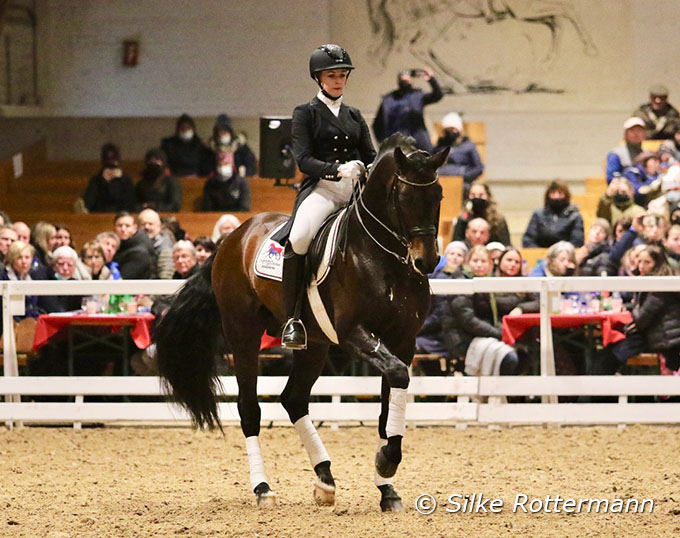
Mother Ingrid stayed at the far end of the arena and occasionally gave some advice to her daughter via the microphone, which was educational for all onlookers as well as for the pair in the arena. Greta showed the monumental stallion in all Grand Prix movements and visibly relaxed in the course of the presentation; smiling all over her face when the sympathetic Berne audience acknowledged the tall blonde’s sensitivity to handle this lively stallion, who was long listed for the Tokyo Games until an injury ruled him out.
Finally the stallion show finished with a trio of stallions from the Münster based Holkenbrink stud: Franziskus, his sons Franz Joseph Junior (*2016 by Franziskus x Rock Forever x -Ferragamo) and French Open (*2017 by Franziskus x Rock Forever x Arpeggio) who showed a little pas de trois to the sound of Beethoven’s "Ode to Joy."
Late in the evening, while I was thawing thanks to the seat heater in my car on the way home to my hosts' house in Thun, I noted to myself that horses are always worth those boring hours in a car and frozen feet. How could I ever have doubted it 24 hours before?
Equestrian Pop Star Status
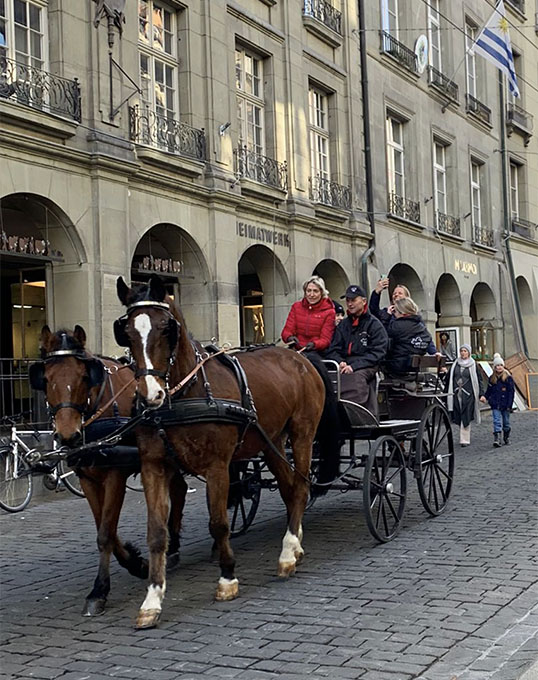
streets of Berne
More clever than the evening before, I had chosen woollen socks in my trendy boots, wrapped a scarf three times around my neck and put a down skirt over my jeans which my frost experienced Finnish friend once recommended buying.
Visitors were dropping in as if on an assembly line well before starting time. The ever friendly staff of the NPZ had their hands full to check tickets, Covid certificates and reply to questions.
I moved away from the already crowded entrance area of the indoor arena and strolled around the historic property, quite well known to me, which once hosted some of the world’s best dressage horses when cavalry riders such as Chammartin, Fischer, Trachsel and Lehmann represented their country at Olympic Games on their army mounts.
The first horses for the lessons arrived and you could sense how excited riders were to soon ride in front of the legend Ingrid Klimke is; and last but not least in front of a full house of spectators.
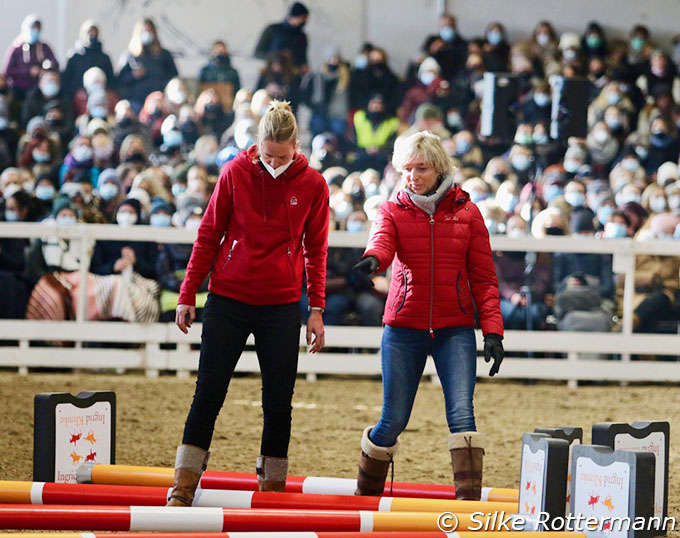
the dressage lesson unit
With some delay the boss of the organizing committee, former 4-in-hand driving champion Werner Ulrich, welcomed the spectators and remembered that Ingrid’s father Dr. Reiner Klimke won two medals at the first ever FEI world dressage championships in 1966 which took place at exactly this place, then the Swiss cavalry school (EMPFA).
The Berne audience then welcomed Ingrid Klimke with thunderous applause which reminded more of a pop star entering the stage than an equestrian event. The double Olympic eventing champion thanked everybody for the nice welcome, not only on that Sunday morning, but already a day earlier when Werner Ulrich had surprised her by picking her up from the station with a horse drawn carriage which Ingrid herself then drove through the historic town of Berne to the National Horse Center.
Calme, En Avant, Droit (Calm, forward, straight)
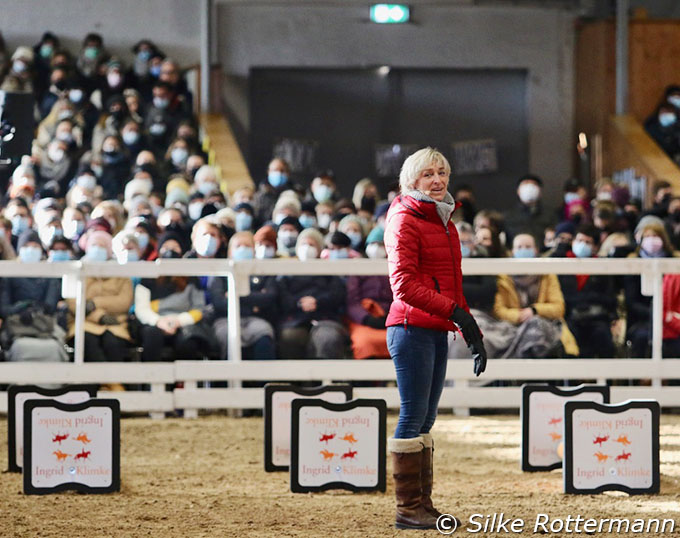
enthused the crowds in Berne
It was a perfectly fitting motto of what Ingrid Klimke would put into practice the next hours in four teaching sessions. In each two riders were taught together.
While the first session was titled "gymnastic lesson," the other three focused on dressage, eventing and jumping - the Olympic disciplines in which Ingrid Klimke has won at the highest levels in her career. Quite a feat in the past, but absolutely extraordinary in our days!
The Warm-up Phase
In this first unit Ingrid Klimke left no doubt that a proper and successful warm-up phase is of uppermost importance and an indispensable precondition for the working phase. Not surprisingly, the two horses in the ring, the 7-year-old Hanoverian Franziskus daughter Mona Lisa and the more experienced 12-year-old Swiss bred gelding Bug’s Bunny were a tiny bit impressed when they entered the ring with so many people on the tribunes watching. And probably their riders felt similarly, but Ingrid’s sensitive way of easing tension in riders and horses alike with her friendly approachable nature soon came into fruition.
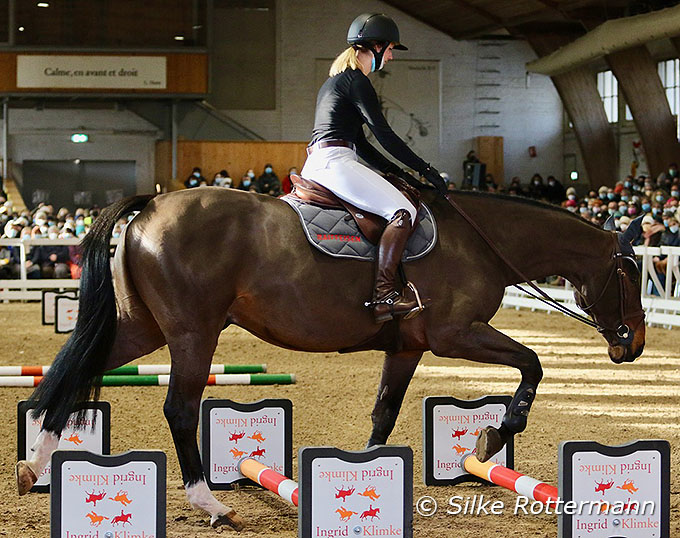
the warm-up. Bug’s Bunny soon took the poles in his stride
Ingrid stressed that „We only use four cavaletti because if something happens the horses still have the chance to jump out." The course of this 'gymnastic lesson' showed that even horses which first did not seem very familiar with cavaletti work can soon be acquainted to it in a good way and profit visibly from it. "In the warm-up phase we have to take care that the first three elements of the training scale: rhythm, relaxation and contact. They are fulfilled," said the 53-year-old from Münster. While the sparky Franziskus-mare needed more time to achieve the elements, the five years older bay gelding soon relaxed during the first trotting phase.
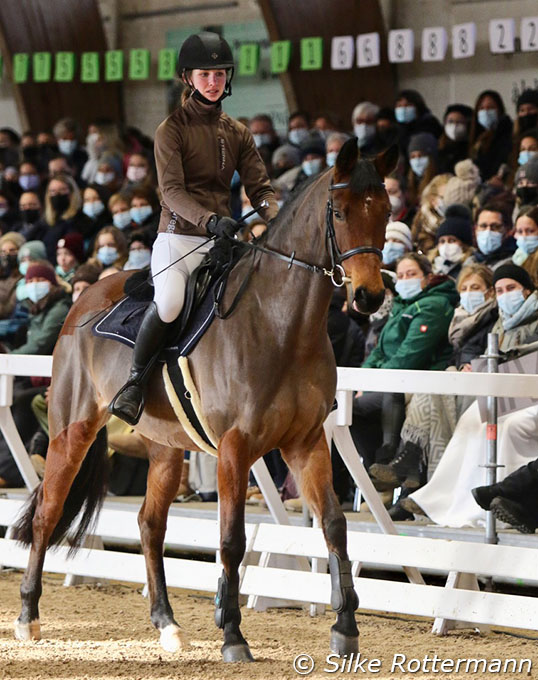
the ring, but with very empathetic riding and the
advice of Ingrid Klimke the pretty mare soon focused
nicely on her work.
When the horses were ready to switch into the working phase, Ingrid reminded the audience of the two essentials that are "the poll needs to be the highest point in this phase and the nose in front of the vertical." Although Ingrid kept both pairs mentally occupied through different exercises, she did not forget to allow breathers in between and cleverly worked a few minutes with one pair, while the other walked her horse and observed what was going on.
In this phase Ingrid used a "pole alley" on the centre line to practice walk-trot and walk-canter transitions. Here the horses needed to prove they are through and on the aids. Whereas Ingrid was always encouraging and also entertaining in the way she gave the lessons, she was also persistent and consequent. Dragging hind-legs in walk-trot- transitions didn’t go unnoticed and were not accepted, until the horse with some good advice from her would show a quicker hind-leg and a clear transition.
Klimke finished the first unit with the two riders asking them to allow their horses to stretch forward and downward in trot. „The horses should always go back to the stables with a really good feeling," she concluded. There was no doubt Mona Lisa and Bug’s Bunny went home as content horses who had behaved incredibly well given that they very possibly have never seen a backdrop like on that day in Berne.
From Olympian to Olympian
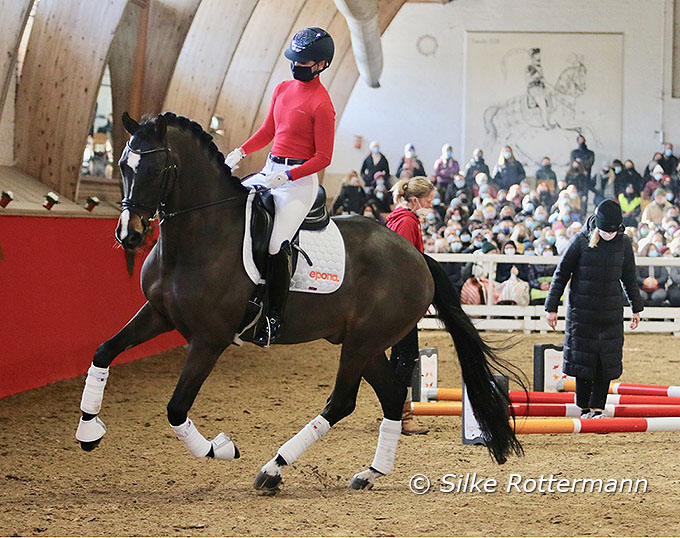
Wettstein, who also loves jumping at high level, is in the enviable position of having three more Grand Prix horses in her stables near Zurich besides Olympic mount West Side Story OLD. For the masterclass she brought Great Escape Camelot (by Johnson x Turbo Magic) to Berne. Stephanie Hartmann, who lives not far from Berne, relied on her long-time partner Lady Gaga, a 15-year-old Rhinelander mare by Licotus x Rubinstein I.
The focus in their lesson was certainly to refine some upper level movements, so both horses entered the arena having already been warmed up in another arena. Both are competed at CDI level, with Great Escape Camelot already being an international Inter 2 and GP Kur winner while Lady Gaga is a confirmed former YR horse training towards Grand Prix.
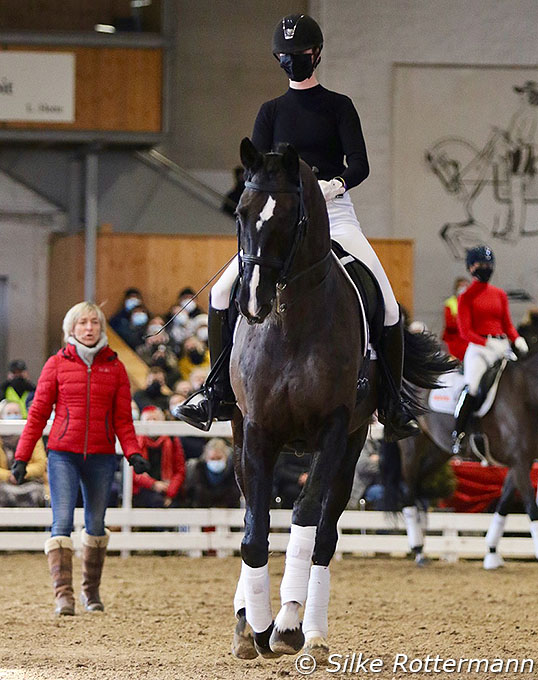
The 11-year-old Dutch bred Great Escape Camelot is a strikingly elegant appearance. The quick hind leg of the bay gelding which naturally steps under the centre of gravity was eye catching. He managed the curved row of cavaletti at the beginning of the lesson without batting an eyelid, played with every kind lateral work and seemed already very confirmed in the canter movements. Actually Ingrid Klimke had comparatively little to do with Wettstein on her Dutch gelding and stressed that at this level it is all about further refinement.
Stephanie Hartmann and Lady Gaga also seemed familiar with the brightly coloured poles, which Ingrid said to foster cadence and expression by activating the hind-legs and loosening the back. With Hartmann Klimke worked among other things on tempi changes and canter pirouettes. The big framed black mare fits his tall rider very well and is an experienced horse.
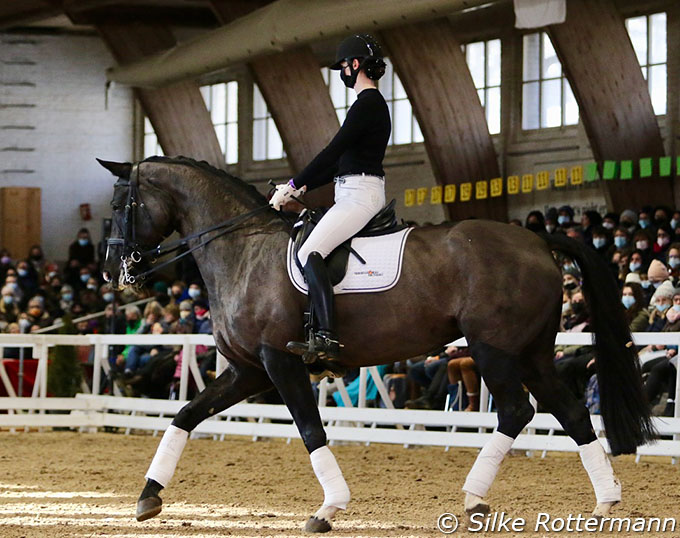
and nose in front of the vertical.
When Ingrid asked both riders to lengthen the reins and trot their mounts in an easygoing way at the end of their lesson, both horses followed the contact and stretched forwards, down and remained in front of the vertical.
Lady Gaga and Great Escape Camelot left the ring side by side in a relaxed walk. It was an unspectacular picture which contained an important message Ingrid allowed to shine through during her two days in Berne: Good training and riding are the only ways to achieve what the FEI calls a "happy (equine) athlete." Dressage is not about creating a tense spectacular striding horse breathing fire through the nostrils, it is about „strengthening the personality of the horse," as Dr. Reiner Klimke once said.
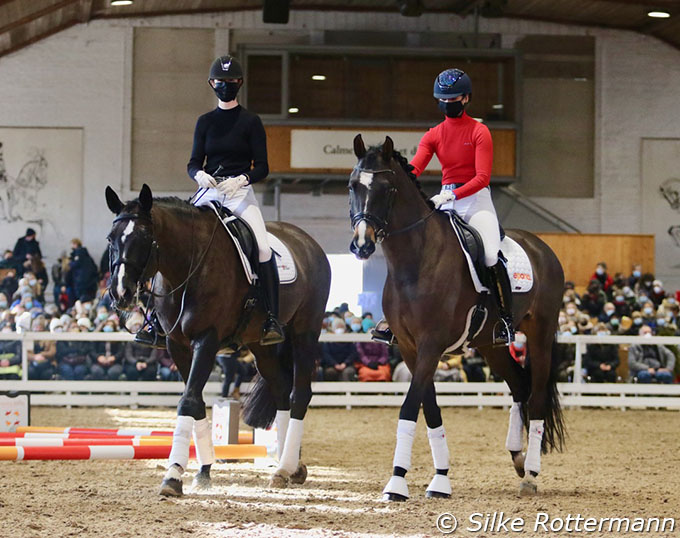
and Fast Escape Camelot
Related Links
Ingrid Klimke: Where Riding Becomes Art
Ruth Klimke, the Backbone of Success in the Klimke Dynasty
Ingrid Klimke: "Correct Riding Is Enough!"
Pierre-Eric Jaquerod: "Swiss Dressage Has Not Woken Up in Time for Transition"
Legendary Olympian Henri Chammartin Passed Away
2014 Helen Langehanenberg Clinic in Berne: "Dare It, It's Only Training!"
2012 European Junior and Young Riders Championships - Table of Contents
Photo Report: 2006 CDI Berne
Eurodressage on the road: The Winding Road to Berne